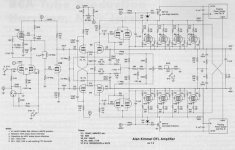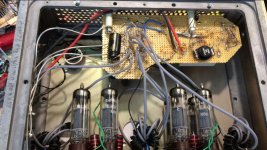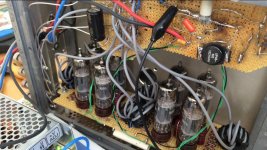During my spare time - I'm working on a tube amp design which uses 6 pass bands to cover the audio spectrum. In order to go down to 4 cycles on the sub-bass ( so I can reproduce pipe organ music ) I have found the output transformer even for a modest 200 watt Tube amp would be humongous, having to be a special wind.
Now I'm looking at OTL designs, which puts me into a different class of output tube.
I was originally going to use 807's as a have a good number of them ( but with transformers ).
Now I recently procured a quite a reasonable number of 6CM5 tubes - mostly used - but many new as well. since these are plentiful, rugged and deliver some reasonable power out in audio - that makes them very attractive for an OTL amp.
For the OTL amp - I was looking at Allan Kimmell's OTL design from issue 8 of Vacuum Tube Valley - http://www.tiffe.de/roehren/VTV/VTV08.pdf - but with maybe using 16x 6CM5 tubes in my 4 bass amps (with 12 amplifiers in total for a full-band stereo.).
Using this approach will reduce cost, weight and difficulty in obtaining transformer parts - but add a different level of complexity to the project.
Has any one used 6CM5 tubes in Kimmell's design - or have a better OTL design using the same ? Looking at the original design - with a few changes - it should work quite well with any of the 6CM5 family of tubes.
[ John Chambers claims in one of his web pages - CHAMP ELECTRONICS - he got 93 watts out of a pair of these tubes and 185 watts out of a quad set - well over the 44 watts a pair claimed in the Philips data book > http://frank.yueksel.org/sheets/030/e/EL36.pdf ]
[/B][/I]
Now I'm looking at OTL designs, which puts me into a different class of output tube.
I was originally going to use 807's as a have a good number of them ( but with transformers ).
Now I recently procured a quite a reasonable number of 6CM5 tubes - mostly used - but many new as well. since these are plentiful, rugged and deliver some reasonable power out in audio - that makes them very attractive for an OTL amp.
For the OTL amp - I was looking at Allan Kimmell's OTL design from issue 8 of Vacuum Tube Valley - http://www.tiffe.de/roehren/VTV/VTV08.pdf - but with maybe using 16x 6CM5 tubes in my 4 bass amps (with 12 amplifiers in total for a full-band stereo.).
Using this approach will reduce cost, weight and difficulty in obtaining transformer parts - but add a different level of complexity to the project.
Has any one used 6CM5 tubes in Kimmell's design - or have a better OTL design using the same ? Looking at the original design - with a few changes - it should work quite well with any of the 6CM5 family of tubes.
[ John Chambers claims in one of his web pages - CHAMP ELECTRONICS - he got 93 watts out of a pair of these tubes and 185 watts out of a quad set - well over the 44 watts a pair claimed in the Philips data book > http://frank.yueksel.org/sheets/030/e/EL36.pdf ]
[/B][/I]
Attachments
One of the first questions to ask yourself is:
What is the DCR of your Sub Woofer voice coil?
At 4 Hz, the AC impedance and the DCR are the same.
Your OTL amp will have to drive this low DCR/low impedance at 4Hz.
Can it drive a 3 Ohm, 4 Ohm, or even 6 Ohm impedance?
Keep in mind that organ bass tones tend to be long sustained notes, not just short music transients. For example, a single vacuum tube may be able to deliver a 1 Amp transient, but not for 10 seconds.
What is the DCR of your Sub Woofer voice coil?
At 4 Hz, the AC impedance and the DCR are the same.
Your OTL amp will have to drive this low DCR/low impedance at 4Hz.
Can it drive a 3 Ohm, 4 Ohm, or even 6 Ohm impedance?
Keep in mind that organ bass tones tend to be long sustained notes, not just short music transients. For example, a single vacuum tube may be able to deliver a 1 Amp transient, but not for 10 seconds.
kimbal, the EL36 datasheet just shows one set of class B PP amp operating levels - with the screen at 150V, and 3.5kohm PP loading. A Philips PA would typically use a 1.75kohm PP loading, with operation starting in class A, and supply rails would nominally be 340V and 170V.
I get 50W clean out of a pair in a standard Philips PA. I suggest you would need new 6CM5, plus individual bias with the low grid leak level, and a careful eye on the health of the 6CM5 over time, and better cooling than Philips PA's typically achieved when they cram the 6CM5's in, to achieve the higher power levels that John ran - no matter what output stage configuration you are attempting.
I get 50W clean out of a pair in a standard Philips PA. I suggest you would need new 6CM5, plus individual bias with the low grid leak level, and a careful eye on the health of the 6CM5 over time, and better cooling than Philips PA's typically achieved when they cram the 6CM5's in, to achieve the higher power levels that John ran - no matter what output stage configuration you are attempting.
I agree with mashaffer.
1.The series voice coils for the subwoofers makes good sense for OTL amplifiers.
2. The rare 64' stops would be at 8 Hz.
I expect that the "4 Hz" tone is merely the beating of two pipes, say one at 16 Hz, and one at 20Hz.
4 Hz is created by:
our ear's intermodulation
the amplifiers intermodulation
the speakers intermodulation.
It is not a real tone from a single pipe.
1.The series voice coils for the subwoofers makes good sense for OTL amplifiers.
2. The rare 64' stops would be at 8 Hz.
I expect that the "4 Hz" tone is merely the beating of two pipes, say one at 16 Hz, and one at 20Hz.
4 Hz is created by:
our ear's intermodulation
the amplifiers intermodulation
the speakers intermodulation.
It is not a real tone from a single pipe.
Last edited:
Wikipedia says >
The lowest note that a pipe organ can sound (with a true pipe) is C−1 (or CCCC), which is 8 Hz, below the range of human hearing and not visible on this chart. However, if acoustic combination (a note and its fifth) counts, the lowest note is C−2 (or CCCCC), which is 4 Hz >
Range (music) - Wikipedia
Obviously these notes you cant hear - but certainly feel them.
YouTube
The above video comments say -
Unfortunately the camera microphone sound just can't go down to 8Hz and 4Hz but this pedal department shakes everything visibly and is a brilliant addition to full organ. Whilst experimenting my wife thought that I had started the tractor outside and upon coming in commented that it sounded like the Titanic's engine room.
After listening to sample pipe organ music on Youtube it has me inspired to build the ultimate home audio amp with TUBES. LOL - yes we've all heard that before !
But realistically - getting any high power audio output transformer that will do less than 10 hertz is a challenge to say the least - let alone go down to 4 hertz.
So to get around this problem I will scrap it and use them in the high frequency amps only - as their power is much easier to source ( ie around 100 watts ). The top end of the audio spectrum is just on 45 Khz.
The lowest note that a pipe organ can sound (with a true pipe) is C−1 (or CCCC), which is 8 Hz, below the range of human hearing and not visible on this chart. However, if acoustic combination (a note and its fifth) counts, the lowest note is C−2 (or CCCCC), which is 4 Hz >
Range (music) - Wikipedia
Obviously these notes you cant hear - but certainly feel them.
YouTube
The above video comments say -
Unfortunately the camera microphone sound just can't go down to 8Hz and 4Hz but this pedal department shakes everything visibly and is a brilliant addition to full organ. Whilst experimenting my wife thought that I had started the tractor outside and upon coming in commented that it sounded like the Titanic's engine room.
After listening to sample pipe organ music on Youtube it has me inspired to build the ultimate home audio amp with TUBES. LOL - yes we've all heard that before !
But realistically - getting any high power audio output transformer that will do less than 10 hertz is a challenge to say the least - let alone go down to 4 hertz.
So to get around this problem I will scrap it and use them in the high frequency amps only - as their power is much easier to source ( ie around 100 watts ). The top end of the audio spectrum is just on 45 Khz.
Last edited:
Is this for use in an outdoor stadium, or do you have 'cathedral' like interior dimensions to allow such a low frequency to be generated by some as yet not detailed speaker or piston system?
I would have thought it would be more practical to start with a speaker system that can generate some suitable level of acoustic pressure without distortion or huge standing waves - aka using motional feedback, and in a stadium.
I would have thought it would be more practical to start with a speaker system that can generate some suitable level of acoustic pressure without distortion or huge standing waves - aka using motional feedback, and in a stadium.
After listening to sample pipe organ music on Youtube it has me inspired to build the ultimate home audio amp with TUBES. LOL - yes we've all heard that before ![/quoote]
Yes, there is nothing like the king of instruments.
Suppose a music hall with a pipe organ in it has a wall that is kind of springy, but the 'spring' does not conform to Hooke's law, because there is some kind material behind the wall, it moves more easily in one direction than the other.
If the pipe organ plays both the 8 Hz and 12 Hz pipes, the wall will create 2nd order intermodulation, and that will produce 12 - 8 = 4 Hz, and 12 + 8 = 20 Hz tones.
Hmm, our eardrums and ear bones are non linear; can we hear the 12 + 8 = 20 Hz tone, even if there is no wall?
If the pipe organ plays both the 8 Hz and 12 Hz pipes, the wall will create 2nd order intermodulation, and that will produce 12 - 8 = 4 Hz, and 12 + 8 = 20 Hz tones.
Hmm, our eardrums and ear bones are non linear; can we hear the 12 + 8 = 20 Hz tone, even if there is no wall?
Wikipedia says >
The lowest note that a pipe organ can sound (with a true pipe) is C−1 (or CCCC), which is 8 Hz, below the range of human hearing and not visible on this chart. However, if acoustic combination (a note and its fifth) counts, the lowest note is C−2 (or CCCCC), which is 4 Hz >
Range (music) - Wikipedia
Wikipedia also says there are only two organs in the world that go that low, Boardwalk Hall Auditorium Organ - Wikipedia and Sydney Town Hall Grand Organ - Wikipedia. 16 Hz is far more usual as the lowest fundamental of a pipe organ. By the way, acoustic combinations don't count unless there is some non-linear thing in between the organ and the microphone that makes difference frequencies. The air itself is non-linear (as the pressure can't drop below 0 Pa), but you'll only notice that at extreme sound pressure levels.
Kimbal,
Don't know if you're still set on the OTL approach or not but if so you might get something out of following this link to Ralph Karsten's post and links. Going on from there you can find schematics for his Atmasphere M-60 (both power supply and signal circuits posted separately) and details on OTLs. I spent twenty minutes poking around and it yielded a lot of good info . HTH.
Don't know if you're still set on the OTL approach or not but if so you might get something out of following this link to Ralph Karsten's post and links. Going on from there you can find schematics for his Atmasphere M-60 (both power supply and signal circuits posted separately) and details on OTLs. I spent twenty minutes poking around and it yielded a lot of good info . HTH.
Kimbal,
Don't know if you're still set on the OTL approach or not but if so you might get something out of following this link to Ralph Karsten's post and links. Going on from there you can find schematics for his Atmasphere M-60 (both power supply and signal circuits posted separately) and details on OTLs. I spent twenty minutes poking around and it yielded a lot of good info . HTH.
+1

Kimbal,
Don't know if you're still set on the OTL approach or not but if so you might get something out of following this link to Ralph Karsten's post and links. Going on from there you can find schematics for his Atmasphere M-60 (both power supply and signal circuits posted separately) and details on OTLs. I spent twenty minutes poking around and it yielded a lot of good info . HTH.
Thanks - Much Appreciated.
If you want to go all the way down to 16Hz with 4 Ohm load then please consider a Zotl instead as you will not waste all the power dissipated by the tubes. The heaters of the tubes alone will consume more the 100 Watt per amp. You will have to replace the tubes every 5 years or so to mentain the output power.
By the way, the Champ amp is no OTL design, it uses output transformers (not shown but they are inside the Geloso amp).
A Zotl can be very small (see attached images). This one is about 10 Watt.
If you want to build a "standard" OTL i suggest the Tim Mellow one.:
http://www.mellowacoustics.com/articles/Tim_Mellow_25w_OTL_Tube_amplifier.pdf
A Zotl can be very small (see attached images). This one is about 10 Watt.
If you want to build a "standard" OTL i suggest the Tim Mellow one.:
http://www.mellowacoustics.com/articles/Tim_Mellow_25w_OTL_Tube_amplifier.pdf
Attachments
- Status
- This old topic is closed. If you want to reopen this topic, contact a moderator using the "Report Post" button.
- Home
- Amplifiers
- Tubes / Valves
- A noval approach to wide-band audio


